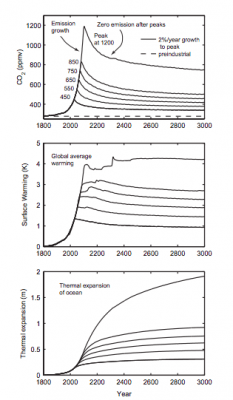In her article, “Irreversible climate change due to carbon dioxide emissions,” Susan Solomon and her colleagues express how the human race has such a large impact on the world’s climate change. The paper focuses on how the effects of increases in carbon dioxide on the atmosphere take around a thousand years to be repaired. Human activities were identified as the most prominent cause of the rise in “atmospheric concentrations of key greenhouse gases.” These increases in greenhouse gases, especially carbon dioxide, will result in a wider range of damaging and possibly irreversible climate changes.
Solomon highlights how complicated the multi-step process of carbon dioxide atmospheric extraction can be. The process includes “rapid exchange with the land biosphere and the surface layer of the ocean through air-sea exchange.” Typically, 20% of the added tonnes of carbon dioxide stay in the atmosphere while 80% becomes mixed in with the ocean. Ocean warming is just one quantifiable aspect of climate change. Unlike methane or nitrous oxide, carbon dioxide is the only greenhouse gas whose gases persist over time rather than periodic instances. The graphs below display the amount of carbon dioxide that is “expected to be retained in the atmosphere by the end of the millennium.”

These three graphs display carbon dioxide and global mean climate system changes. Results are represented with an 11-yr running mean.
Overall, the main point of Solomon’s article was to highlight how irreversible these small but detrimental gas emissions can be to our climate. Changes in sea levels, changes in precipitation, and changes in atmospheric warming can all be traced back to the increase in CO2 emissions into the atmosphere. Not only are these changes dangerous to the environment, but also play a vital role in the timeline of mankind.


An interesting point, as you mentioned, is that climate change is irreversible. We cannot fix it, we only have the power to look back on the damages already done.
I thought it was interesting how the article you chose analyzed ocean temperature due to CO2 concentration in our atmosphere. The article I read talked about how these concentrations alter the pH level in the ocean. However, when reading your post, I learned it also increases the temperature of the ocean, which most definitely has an impact on marine life.
Therefore, this shows that the destruction done by CO2 levels in the atmosphere go deeper than what we can visibly see. We think that these small changes barely have an impact, when in reality they have an extremely detrimental effect on a variety of aspects in our environment.
I found this article very informative in regards to the effects carbon dioxide has on marine life. It explains how the damage we’ve done to marine life is irreversible and we can only learn from our mistakes because we cannot change the past. I also found it interesting when you mentioned that, “Carbon Dioxide is the only greenhouse gas whose gases persist over time rather than periodic instances.” Having stated this, it becomes evident how detrimental our actions toward the environment is. However, with a continuous effort, we can help slow the damage we’ve done by learning from our mistakes.
Wow. Impressive stuff.
I am a passionate supporter of marine wildlife.I personally own more than 12 fish. I did not know that 80 percent of the CO2 in the atmosphere gets mixed in the ocean. It makes me wonder, how does that effect the fish and in turn the humans and other animals that eat them. I think the damage being done by CO2 should be at the forefront of change and I hope I can help be apart of the solution.
Good read Elly.
-Ryan
Reading your post right after Mackenzie’s was incredibly eye opening. I had no idea that 80 percent of CO2 was trapped in the ocean making the numbers Mackenzie reported on much more based in reality. I also don’t think that people, in general, have a good grasp of how long CO2 emissions will linger from everyday activities. I had no idea that it takes around a thousand years for CO2 damage to be repaired. Which creates an even bigger emphasis of teaching mindfulness as a lifestyle to younger generations, and to teach them how to be aware of their carbon footprint.